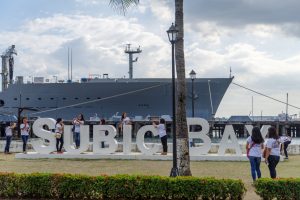The recently concluded Trilateral Summit of the United States, Japan, and the Philippines saw the unveiling of the Luzon Corridor, an economic scheme that is intended to spur economic partnerships among the three countries. Located south of Taiwan, Luzon is the Philippines’ biggest island with five regions including Metro Manila, the country’s capital region and major urban center.
Luzon Corridor is reported as the first project of the U.S.-initiated Partnership for Global Infrastructure and Investment in the Indo-Pacific, which is touted as an alternative to China’s Belt and Road Initiative and Maritime Silk Road. It encompasses big ports (Batangas and Manila) and economic zones (Subic and Clark). The latter were previously U.S. military bases, until they were turned into commercial areas in 1991.
The summit paper emphasized that the Luzon Corridor will accelerate coordinated investments in high-impact infrastructure projects such as rail, telecommunications, and port modernization. Philippine President Ferdinand “Bongbong” Marcos Jr. is confident that the initiative will attract investments soon.
“We’ll start to see, we can actually, not even years, within the year, we will start to begin, to see the wisdom of having that trilateral agreement and why it is a good thing to enter into,” he said in a media interview.
The U.S. and Japan invaded the Philippines by capturing Manila, Luzon’s biggest city. The Battle of Manila Bay in 1898 allowed the U.S. to acquire the Philippines from its colonial ruler, Spain. Manila was declared an open city in December 1941 right before the invasion of Japan.
The fall of Bataan in 1942 in central Luzon forced the U.S. military command to flee the country. In 1945, U.S. forces landed in Lingayen in north Luzon which eventually led to the defeat and expulsion of Japanese troops. Manila was liberated but not after it was heavily destroyed by Japanese and U.S. forces. Next to Warsaw, Manila was the second most devastated Allied city during the war. For almost a century, Subic and Clark represented the enduring political influence of the U.S. in the country.
The nation’s wealth and political power was concentrated in Luzon, as Manila expanded into Metro Manila composed of 16 cities and a municipality. Most of the country’s presidents were from landed families and political dynasties based in Luzon. Marcos’ family hails from the Ilocos region of north Luzon. The narrative of “imperial Manila” is often used as political rhetoric against inequality, uneven development, and the notorious legacy of the Manila-based elite in dominating the rest of the country.
Landlessness and land conflicts fueled the communist-led insurrection in central Luzon in the late 1940s up to the early 1950s. The Marcos dictatorship was challenged by an armed resistance rooted in the rural and mountainous provinces of Luzon. The armed communist movement thrived even after the ouster of Marcos in 1986.
The concept of developing a growth area in Luzon is not new. Former President Gloria Arroyo’s “super regions” program featured the establishment of an urban corridor and digital highway covering the urban centers of Luzon.
China has funded mega projects in Luzon in recent years like the ongoing construction of Kaliwa Dam, intended to boost Metro Manila’s water and power supply, and several dams in the Cordillera Region in north Luzon.
Since 2014, the U.S. has built military facilities across Luzon through the Enhanced Defense Cooperation Agreement (EDCA). In Central Luzon, these facilities are found in Basa Air Base in the province of Pampanga and Fort Magsaysay in Nueva Ecjia Province. After Marcos became president in 2022, he added three more EDCA sites in Luzon, Cagayan and Isabela provinces. Cagayan is a northern Luzon province located near Taiwan. Recent Balikatan (“shoulder-to-shoulder”) military exercises between U.S. and Philippine troops have taken place in the fields and coastal areas of Central Luzon.
The unveiling of the Luzon Corridor was followed by government pronouncements highlighting the potential huge economic gains of the country in terms of the jobs, livelihoods, and economic opportunities to be generated by the combined investments of the U.S. and Japan. What is overlooked is the proximity of EDCA sites in the Luzon Corridor. Subic, which is part of the Luzon Corridor, has reportedly become a fuel depot for the U.S. military. The Luzon Corridor blurs the increasing military footprint of the U.S. on its former colony.
For those who support Marcos’ pivot to the U.S., the Luzon Corridor is a testament to the commitment of the Biden government to strengthen the security partnership of the two countries with concrete and generous trade and investment windfall for the Philippines. But for those critical or against the expansion of U.S. military presence in the country, the Luzon Corridor is nothing but an extension of EDCA that will facilitate the greater exploitation of cheap labor and the plunder of the country’s resources by American and Japanese corporations.
Unlike previous economic treaties, the Luzon Corridor is linked to increasing military buildup on the island and the intensified rivalry between the U.S. and China. It was announced two weeks before the staging of a massive Balikatan exercise and the prepositioning of U.S. missiles in the country.
Luzon has witnessed some of the most brutal acts of colonial conquest and war over the past century. Will the Luzon Corridor be any different by ushering in an era of peace and stability in this designated zone of growth and development?
































